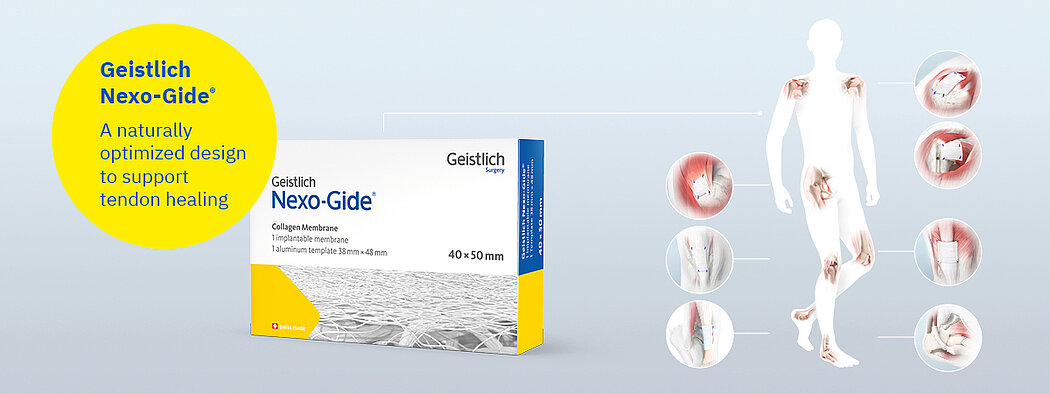Geistlich Nexo-Gide®

Proven Scientific Evidence
The Dual Surfaces found in Geistlich Nexo-Gide® have been shown in pre-clinical and in vitro testing to provide an environment where cells migrate, proliferate, and differentiate, which supports the formation of new tissue.1–3
- In vitro testing with cells demostrated retention characteristics that support the maintenance of cells in the location desired1.
- It was demonstrated in pre-clinical testing that the incidence and severity of surrounding tissue attachment was reduced as compared to the surgical control. This may result in decreased post-operative complications.1
- In vitro testing with cells demonstrated that the Geistlich Nexo-Gide® provides an environment where cells migrate, proliferate and differentiate1,2.
References:
- Data on file
- Gantenbein B, et al. World J Stem Cells. 2015; 7(2): 521–534.
- Fulco I, et al. Lancet 2014; 384: 337–46.
- Lo IKY, et al. Am J Sports Medicine. 2004;32(5):1223–1229.
- Robertson CM, et al. Am J Sports Medicine. 2012;40(9):1993–2001.
- Alfredson H, et al. J Orthopaed Res. 2003;21(6):970–975.
- Bedi A, et al. J Shoulder Elb Surg. 2010;19(3):384–391.
- Del Buono, et al. J Shoulder Elb Surg. 2012 Feb;21(2):200–8.
MMP Activity and Tendon Healing
Elevated MMP activity after tendon injury has been associated with deterioration of the collagen network4. Significant increases of MMP-13 were found in patients undergoing rotator cuff repair for full thickness tears4 while MMP-1 and -9 were seen to be elevated in tendons of patients which had failed healing of the rotator cuff5. Finally, Alfredson et al showed an upregulation of MMP-2 expression in achilles tendinopathy6.
Reduction of MMP activity close to the repair site may improve tendon healing7. Geistlich Nexo-Gide® is shown to modulate the activity of MMPs related to tendon repair in vitro. Incubation of MMPs 1, 2, 9 and 13 with Geistlich Nexo-Gide® led to a reduction of MMP activity1.
Conclusion: Geistlich Nexo-Gide® has demonstrated the ability to modulate MMP activity in vitro1. Modulation of MMP activity after rotator cuff repair may reduce pathologic tissue degradation and favorably influence healing after rotator cuff repair6.
References:
- Data on file
- Gantenbein B, et al. World J Stem Cells. 2015; 7(2): 521–534.
- Fulco I, et al. Lancet 2014; 384: 337–46.
- Lo IKY, et al. Am J Sports Medicine. 2004;32(5):1223–1229.
- Robertson CM, et al. Am J Sports Medicine. 2012;40(9):1993–2001.
- Alfredson H, et al. J Orthopaed Res. 2003;21(6):970–975.
- Bedi A, et al. J Shoulder Elb Surg. 2010;19(3):384–391.
- Del Buono, et al. J Shoulder Elb Surg. 2012 Feb;21(2):200–8.




